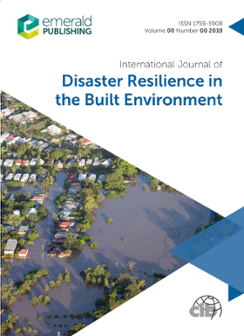International Journal of Disaster Resilience in the Built Environment: Volume 7 Issue 2
Table of contents - Special Issue: United Nations Global Assessment Report 2015 on Disaster Risk Reduction
The urban domino effect: a conceptualization of cities’ interconnectedness of risk
Christine Wamsler, Ebba BrinkCities are both at risk and the cause of risk. The interconnectedness of urban features and systems increases the likelihood of complex disasters and a cascade or “domino” effect…
Multi-risk approach and urban resilience
Nadejda Komendantova, Anna Scolobig, Alexander Garcia-Aristizabal, Daniel Monfort, Kevin FlemingUrban resilience is becoming increasingly important due to increasing degree of urbanization and a combination of several factors affecting urban vulnerability. Urban resilience…
Critical infrastructure interdependence in New York City during Hurricane Sandy
Masahiko Haraguchi, Soojun KimThis study aims to investigate the impact of Hurricane Sandy from the perspective of interdependence among different sectors of critical infrastructure in New York City and to…
Implications of cascading effects for the Hyogo Framework
Sibel McGee, Jaime Frittman, Seongjin James Ahn, Susan MurrayThis paper aims to provide a preliminary systemic portrayal of risk relationships in the context of critical infrastructures (CIs) during disasters and assess the adequacy of the…
Land use planning for disaster risk reduction and climate change adaptation: Operationalizing policy and legislation at local levels
David King, Yetta Gurtner, Agung Firdaus, Sharon Harwood, Alison CottrellThe Hyogo Framework for Action focussed disaster risk reduction (DRR) on land-use planning, with international agencies, research organisations and national governments…
Improving construction sector resilience
Suzanne Wilkinson, Alice Yan Chang-Richards, Zulkfli Sapeciay, Seosamh B. CostelloImproving the resilience of the construction sector helps countries recover quicker from crises and can assist with improving community resilience and recovery. This study aims to…
Understanding risk: what makes a risk assessment successful?
Richard Murnane, Alanna Simpson, Brenden JongmanUnderstanding risk is more than just modeling risk; it requires an understanding of the development and social processes that underlie and drive the generation of disaster risk…
Measuring disaster resilience in communities and households: Pragmatic tools developed in Australia
Paul Arbon, Malinda Steenkamp, Victoria Cornell, Lynette Cusack, Kristine GebbieThis paper aims to discuss the development of two toolkits that were designed to help communities and households measure their level of disaster resilience and provide practical…
Linking disaster risk reduction, climate change and development
E. Lisa F. Schipper, Frank Thomalla, Gregor Vulturius, Marion Davis, Karlee JohnsonThe purpose of this paper is to advance the dialogue between the disaster risk reduction (DRR) and adaptation community by investigating their differences, similarities and…

ISSN:
1759-5908Online date, start – end:
2010Copyright Holder:
Emerald Publishing LimitedOpen Access:
hybridEditors:
- Prof Dilanthi Amaratunga
- Prof Richard Haigh